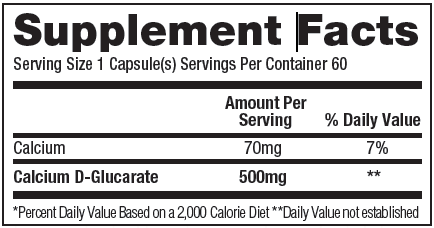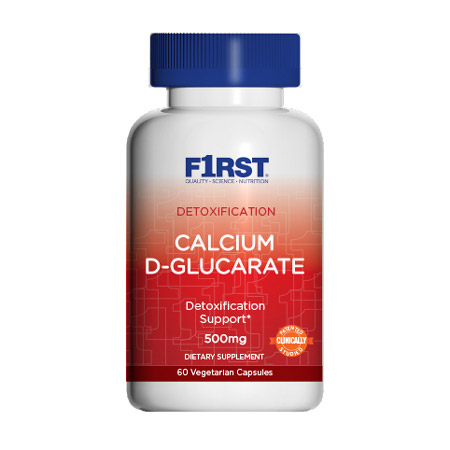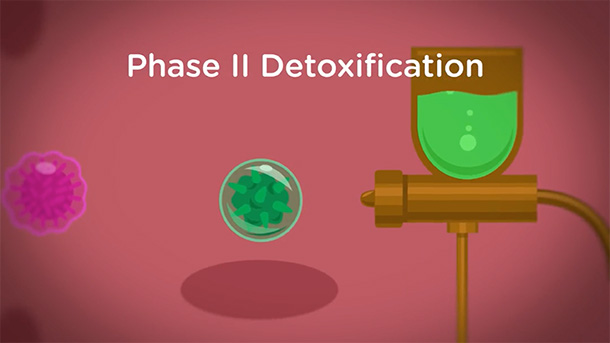How does Calcium D-Glucarate work in the body?
- Xenobiotics (such as drugs and other chemicals), hormones (such as estrogen) and other fat-soluble toxins are processed in the Phase II liver detoxification pathway. The product of that process is the chemical transformed into a water-soluble molecule that can be excreted from the body.
- Calcium D-Glucarate ingested into the body is metabolized in the acid environment of the stomach into D-glucaric acid.
- D-glucaric acid is further metabolized into at least three compounds. The key active form is thought to be D-glucaro-1,4-lactone.
- In the intestines, the microflora (bacteria) produce an enzyme called beta-glucuronidase. This enzyme can break down the water-soluble molecules formed in detoxification and liberate the toxin. But D-glucaro-1,4-lactone interferes with that deconjugation process so that the glucuronide can be excreted safely from the body.
Without the inhibition of beta-glucuronidase by a beta-glucuronidase inhibitor like Calcium D-Glucarate, the toxin would not be properly eliminated and some or all may be reabsorbed.
Where does the Beta-Glucuronidase come from?
Beta-glucuronidase is a bacterial enzyme produced in the gut by the anaerobic bacteria such as from the genera , Bacteroides, and Clostridia. Composition of intestinal bacteria, which can be influenced by aging, diet and other factors, may influence the amount of beta-glucuronidase present. As we age, once “healthy” bacteria in our large intestine, such as Lactobacillus or Bifidobacterium, to which we only associate with positive health benefits, start to increase their beta-glucuronidase activity.6 Research has been shown that “upgrading” beneficial bacteria in the gut as you age with probiotics can help to reduce levels of beta-glucuronidase activity.7-8
By uncoupling glucuronides, beta-glucuronidase can deconjugate molecules processed in the Phase 2 detoxification pathway, thus limiting the proper functioning of thebody’s natural detoxification system.
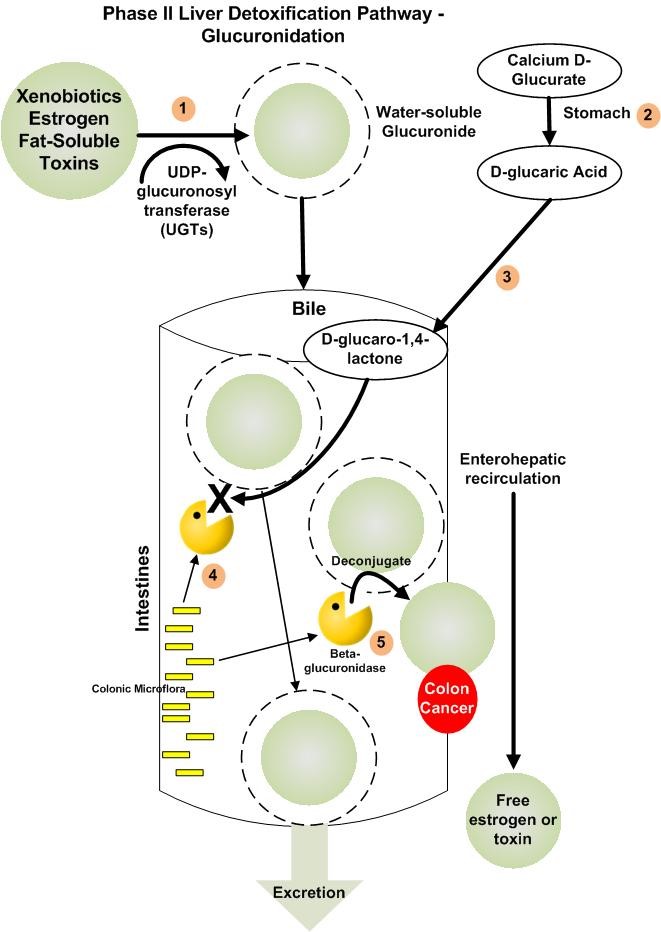
How does diet affect healthy detoxification
For good health, the USDA urges Americans to eat more fruits and vegetables – 5 to 9 servings per day.10 At a minimum, Americans should eat at least two servings of fruit and three servings of vegetables each day as part of a healthy diet. Fruits and vegetables provide numerous nutrients and phytochemicals that support overall health. Some of the nutrients and phytochemicals help support healthy detoxification.
According to findings by the USDA, only 11% of adults meet the USDA guidelines for eating fruits and vegetables.
Foods with the highest concentration of D-glucaric acid include oranges, apples, grapefruit, and cruciferous vegetables.11 Since most Americans are not meeting their dietary intake needs for fruits and vegetables, it is unlikely they may be consuming limited amounts of D-Glucaric acid, which inhibits the beta-glucuronidase enzyme.1,12
Not all fruits and vegetables have the same biological impact on serum levels of beta-glucuronidase activity measured in humans.13 The strongest correlation between dietary components and lowered beta-glucuronidase activity were:
- Plant protein
- Dietary fiber
- Squash and melons
- Legumes
- Apples
What other dietary approaches support health and detoxification?
The following dietary changes may help to support healthy detoxification and general health.
- High-fiber diet (including both soluble and insoluble fiber)13
- Fructooligosaccharides (FOS). FOS may act as a substrate for bifidobacteria.
- Low- or non-meat diet. Lacto-vegetarian diets are associated with reduced levels
of beta-glucuronidase.17
Certain dietary changes can promote overall health as well as supporting a healthy detoxification system. Various dietary components and nutrients can directly and indirectly support the detoxification pathways,Supplemental. Calcium D-Glucarate can be part of the comprehensive strategy for promoting healthy detoxification and well-being.
Calcium D-Glucarate Patents
Calcium D-Glucarate is licensed from Applied Food Sciences, LLC and protected by U.S. Patents 4,845,123; 5,364,644; 5,561,160.
Calcium D-Glucarate Limitations and Considerations
Calcium D-Glucaric supplements may potentially increase the rate of excretion of some pharmaceuticals that themselves are subject to glucuronidation, and thus should not be used alongside medicines without the approval of a medical doctor.
Furthermore, all steroid hormones in the body (testosterone, estrogen, DHEA, etc.) are also glucuronidated. If using an oral dose that reduces the toxin, these hormones will also all be reduced for a short time.
Glucaric acid, via increasing excretion of toxin that are normally subject to this particular detoxification pathway (glucuronidation), can reduce the time a toxin can act in the body and thus reduce the overall cancer causing effects of the toxin. This has been noted in rats repeatedly, but albeit using remarkably high doses (human equivalent is about 200mg/kg bodyweight minimum).
Glucaric acid does not have any inherent anti-cancer effects and may not protect against toxins that are not subject to glucuronidation. The anticancer effects of glucaric acid appear to be very specific to increasing drug excretion rates, and organic cancer (produced from inflammation and oxidation) may not be protected against with glucaric acid supplementation.
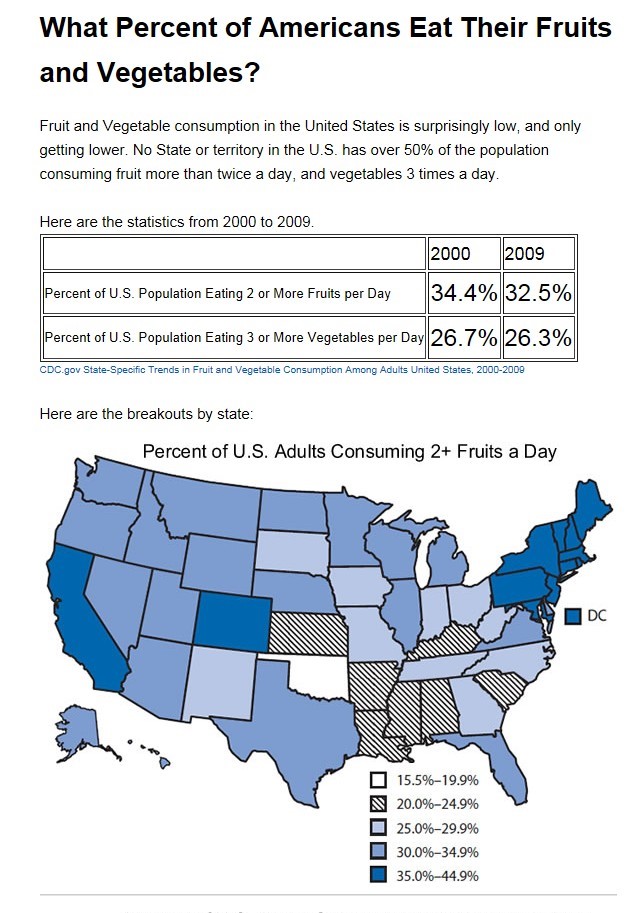
Appendix A: References
- Calcium-D-glucarate. Altern Med Rev 2002;7(4):336-9.
- Mroczynska M, Libudzisz A. Beta-glucuronidase and beta-glucosidase activity of Lactobacillus and Enterococcus isolated from human feces. Polish Journal of Microbilogy. 2010, Vol.59, No 4, 265-269.
- Goldin BR, Swenson L, Dwyer J, Sexton M, Gorbach SL. Effect of diet and Lactobacillus acidophilus supplements on human fecal bacterial enzymes. J Natl Cancer Inst 1980;64(2):255-61.
- Ling WH, Korpela R, Mykkanen H, Salminen S, Hanninen O. Lactobacillus strain GG supplementation decreases colonic hydrolytic and reductive enzyme activities in healthy female adults. J Nutr 1994;124:18-23.
- U.S Fruit and Vegetable Consumption. Who, What, Where, and How Much. USDA. Agriculture Information Bulletin Number 792-2. October 2004.
- Dwivedi C, Heck WJ, Downie AA, et al. Effect of calcium glucarate on beta-glucuronidase activity and glucarate content of certain vegetables and fruits. Biochem Med Metab Biol 1990 Apr;43(2):83-92.
- Yoshimi N, Walaszek Z, Mori H, et al. Inhibition of azoxymethaneinduced rat colon carcinogenesis by potassium hydrogen D-glucarate. Int J Oncol 2000 Jan;16(1):43-8.
- Lampe JW, Li SS, Potter JD, King, Irena B. Serum beta-glucuronidase activity is inversely associated with plant food intakes in humans. Nut. Epidemiology-Research Communication. Experimental Biology 2000.
- Gudiel-Urbano M, Goni I. Effect of short-chain fructooligosaccharides and cellulose on cecal enzyme activities in rats. Ann Nutr Metab 2002;46(6):254-8.
- Reddy BS, Weisburger JH, Wynder EL. Fecal bacterial beta-glucuronidase: control by diet. Science 1974;183(123):416-7. 21 Goldin BR, Adlercreutz H, Gorbach SL, et al. Estrogen excretion patterns and plasma levels in vegetarian and omnivorous women. N Engl J Med 1982 Dec 16;307(25):1542-7.
- Kim DH, Kang HJ, Kim SW, Kobashi K. pH inducible beta-glucuronidase and beta-glucuronidase of intestinal bacteria. Chem Pharm Bull 1992;40(6):1667-9.
Appendix B: Additional References
Dwivedi C, et al. Effect of calcium glucarate on beta-glucuronidase activity and glucarate content of certain vegetables and fruits. Biochem Med Metab Biol. (1990)
Walaszek Z, Szemraj J, Narog M, et al. Metabolism, uptake, and excretion of a D-glucaric acid salt and its potential use in cancer prevention. Cancer Detect Prev 1997;21(2):178-90.
Webb TE, Pham-Nguyen MH, Darby M, Hamme AT 2nd. Pharmacokinetics relevant to the anti-carcinogenic and anti-tumor activities of glucarate and the synergistic combination of glucarate:retinoid in the rat.
Abou-Issa, H., et al. Realtive efficacy of glucurtae on the initiation and promotion phases of rat mammary carcinogenesis. Anticancer Res. 1995 May-Jun;15(3):805-10.
Heerdt AS, et al. Calcium glucarate as a chemopreventive agent in breast cancer. Isr J Med Sci 1995;31:101-5.
 Calcium D-Glucarate is the patented and clinically studied form of glucarate, which occurs naturally in foods such as fruits and vegetables. Glucarate has been shown in studies to support the body’s process of detoxification and to support a healthy liver function.* Calcium D-Glucarate is safe to be taken daily by people seeking to support the body’s natural detoxification processes.
Calcium D-Glucarate is the patented and clinically studied form of glucarate, which occurs naturally in foods such as fruits and vegetables. Glucarate has been shown in studies to support the body’s process of detoxification and to support a healthy liver function.* Calcium D-Glucarate is safe to be taken daily by people seeking to support the body’s natural detoxification processes.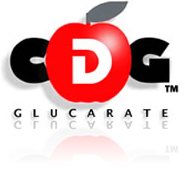 is licensed from Applied Food Sciences, Inc. and protected by U.S. patent 7,662,863.
is licensed from Applied Food Sciences, Inc. and protected by U.S. patent 7,662,863. Calcium D-Glucarate is the patented and clinically studied form of glucarate, which occurs naturally in foods such as fruits and vegetables. Glucarate has been in clinical studies to support the body’s process of detoxification and to support a healthy liver function.*
Calcium D-Glucarate is the patented and clinically studied form of glucarate, which occurs naturally in foods such as fruits and vegetables. Glucarate has been in clinical studies to support the body’s process of detoxification and to support a healthy liver function.*